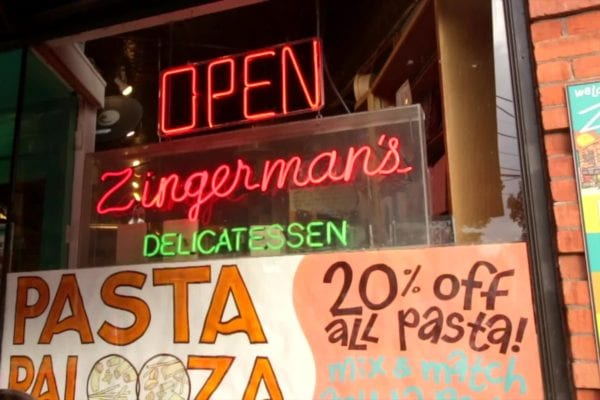Skift Take
Now that plastic bags and straws are out of the way, a San Francisco lawmaker has introduced legislation to ban paper receipts. Sustainable restaurant operations are important, but are these bans the best use of the industry's resources when it comes to downsizing environmental impact?
— Erika Adams
Can grandstanding empty the oceans of plastics and the landfills of trash?
For the last five years, California’s been conducting an experiment to find out. In 2016, the state enacted a limited plastic-bag ban. This year, a new law forbids most restaurants from distributing plastic straws unless requested by a customer. Next up? A San Francisco lawmaker has introduced legislation to ban paper receipts unless a customer specifically asks for one. If adopted, proponents argue, the environmental and health benefits will be significant.
In reality, the “Skip the Slip” measure would have almost no impact on either. Instead, like the plastic-straw ban that preceded it, and which it emulates, the receipt ban is simply another low-impact environmental campaign that asks little of Californians and will accomplish less. Worse, it diverts attention and effort from bigger and far more pressing waste and recycling issues that are negatively impacting the state right now.
One reason campaigns such as these gain public traction is that they appear to have data on their side. For example, according to a widely cited May 2018 report authored by Green America, the organization that inspired the “Skip the Slip” crusade, receipts in the U.S. consume 10 million trees and 21 billion gallons of water, while generating 686 million pounds of waste and 12 billion pounds of CO2. In addition, they cite studies showing that 93 percent of paper receipts are coated in BPA or BPS — endocrine-disrupting chemicals associated with plastic manufacture and subject to high-profile campaigns by parents who want to eliminate them from children’s products.
But, as with straws, the data and assumptions behind the receipt campaign look shaky. In 2018, the FDA issued preliminary findings from a multi-year study of BPA in which it found that “currently authorized uses of BPA continue to be safe for consumers.” Meanwhile, receipt manufacturers have been shifting to BPA alternatives for several years now.
The widely circulated claims about the environmental impacts of paper receipts are even more suspect. For example, Green America’s estimate of how many paper receipts are produced for Americans came from a now-defunct electronic receipt company and “likely assessed production for 2009 or 2010,” according to a Green America representative. The group plans to update its report using 2015 data that suggests only half as much paper — 314,000 tons — is used in receipt-making. That would presumably also slash their estimate of 10 million felled trees to five million, and 12 billion pounds of CO2 to six billion.
Those might still sound like big numbers. But, in context, they’re not. Even 314,000 tons of paper receipts amount to less than .08 percent of the more than 400 million tons of all paper products — receipts to cardboard — used globally on an annual basis. Paper receipts, as anybody in California can surmise by taking a look at their recycling and trash bins, are rounding errors (and shrinking rounding errors, at that, thanks to the rise of digital payments).
What’s really filling up California’s trash bins? Increasingly, it’s cardboard and other packaging left over from e-commerce shipments. In 2017, a spokesperson for Recology Inc., San Francisco’s recycling contractor, called this the “Amazon Effect” and blamed it for the company’s surge in spending on new routes and additional labor, trucks and other equipment. A few weeks later the city approved a 14 percent hike in garbage fees to help cover the new costs. One analyst expects the global market for e-commerce packaging to grow 14 percent annually through 2022.
Ideally, all that cardboard could be recycled at no extra cost to anyone. But, last year, China — the biggest buyer of California’s recycling — slammed the door on many imported recyclables. State recycling programs that were once self-sustaining, and even profitable, started losing money, raising rates and seeking new locations for their trash — including landfills.
In time, California might yet find somewhere new to sell all its Amazon boxes. But, the current situation should alarm environmentalists and spur serious proposals (how about making it easier for paper mills and plastics recyclers to set up shop in California?) to create sustainable, long-term solutions to the state’s waste and recycling problems.
Bans on paper receipts and straws are not those proposals. In fact, by requiring so little of California consumers — forgo a slip of paper! — they prove their lack of seriousness and only serve to distract the state from addressing one of its most complex issues. Advocates who are serious about addressing California’s current and future environmental challenges will skip such campaigns.
Adam Minter is a Bloomberg Opinion columnist. He is the author of “Junkyard Planet: Travels in the Billion-Dollar Trash Trade.”
©2019 Bloomberg L.P.
This article was written by Adam Minter from Bloomberg and was legally licensed through the NewsCred publisher network. Please direct all licensing questions to [email protected].





